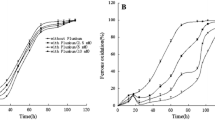Abstract
The uptake and cellular distribution of UO 2+2 were investigated in washed cell suspensions of Thiobacillus ferrooxidans. The uptake was dependent on external concentration of uranium (0.01–10.0 mM) and was influenced by the pH of the reaction mixture, but not by 1 mM transition metals ions or by the previous growth history of the cells. Cells inactivated by either ultraviolet radiation or potassium cyanide accumulated about 40% more uranium than did viable cells especially at a high, toxic UO 2+2 concentration. Most of the uranium was associated with the cell wall and membrane fractions and relatively little uranium was detected in the cytoplasmic, lipopolysaccaride and periplasmic space material fractions. Cells poisoned with potassium cyanide were found to have an 8 to 11-fold increase in the cytoplasmic concentration of uranium.
Similar content being viewed by others
Abbreviations
- LPS:
-
lipopolysaccharide
- NAA:
-
neutron activation analysis
References
Beveridge TJ (1978) The response of cell walls of Bacillus subtilis to metals and to electron-microscopic stains. Can J Microbiol 24:89–104
Cox JC, Nicholls DG, Ingledew WJ (1979) Transmembrane electrical potential and transmembrane pH gradient in the acidophile Thiobacillus ferro-oxidans. Biochem J 178:195–200
Derry R, Garrett KH, Le Roux NW, Smith SE (1976) Bacterially assisted plant process for leaching uranium ores. In: Jones MJ (ed) Geology, mining and extractive processing of uranium. Institution of Mining and Metallurgy, London, pp 56–62
DiSpirito AA, Tuovinen OH (1981) Oxygen uptake coupled with uranous sulfate oxidation by Thiobacillus ferrooxidans and T. acidophilus. Geomicrobiol J 2:275–291
DiSpirito AA, Tuovinen OH (1982a) Uranous ion oxidation and carbon dioxide fixation by Thiobacillus ferrooxidans. Arch Microbiol 133:28–32
DiSpirito AA, Tuovinen OH (1982b) Kinetics of uranous ion and ferrous iron oxidation by Thiobacillus ferrooxidans. Arch Microbiol 133:33–37
Forsberg CW, Costerton JW, MacLeod RA (1970) Separation and localization of cell wall layers of a gram negative bacterium. J Bacteriol 104:1338–1353
Hayat MA (1981) Principles and techniques of electron microscopy. Biological applications, vol. 1 (2nd ed). University Park Press, Baltimore
Horikoshi T, Nakajima A, Sakaguchi T (1979) Uptake of uranium from sea water by Synechococcus elongatus. J Ferment Technol 57:191–194
Horikoshi JT, Nakajima A, Sakaguchi T (1981) Studies on the accumulation of heavy metal elements in biological systems. XIX. Accumulation of uranium by microorganisms. Eur J Appl Microbiol Biotechnol 12:90–96
Lowry OH, Rosebrough NJ, Farr AL, Randall RJ (1951) Protein measurements with the Folin phenol reagent. J Biol Chem 193:265–275
Manchee RJ (1977) Laboratory-scale bacterially assisted leaching of Canadian uranium ores. Trans Instn Min Metall C80:126–133
Matin A, Wilson B, Zychlinsky E, Matin M (1982) Proton motive force and the physiological basis of delta pH maintenance in Thiobacillus acidophilus. J Bacteriol 150:582–591
Nakajima A, Horikoshi T, Sakaguchi T (1981) Studies on the accumulation of heavy metal elements in biological systems. XVII. Selective accumulation of heavy metal ions by Chlorella regularis. Eur J Appl Microbiol Biotechnol 12:76–83
Norris PR, Kelly DP (1978) Toxic metals in leaching systems. In: Murr LE, Torma AE, Brierley JA (eds) Metallurgical applications of bacterial leaching and related microbiological phenomena. Academic Press, New York, pp 83–102
Sakaguchi T, Horikoshi T, Nakajima A (1978) Uptake of uranium from sea water by microalgae. J Ferment Technol 56:561–565
Shumate SE, Stranberg GW, McWhirter DA, Parrot JR, Bogacki GM, Locke BR (1980) Separation of heavy metals from aqueous solutions using “biosorbents” — development of contacting devices for uranium removal. Biotechnol Bioeng Symp 10:27–34
Sprey B, Bochem H-C (1981) Uptake of uranium into the alga Dunaliella detected by EDAX and LAMMA. Fres Z Anal Chem 308:239–245
Strandberg GW, Shumate SE, Parrot JR (1981) Microbial cells as biosorbents for heavy metals: accumulation of uranium by Saccharomyces cerevisiae and Pseudomonas aeruginosa. Appl Environ Microbiol 41:237–245
Sugio T, Tano T, Imai K (1981) Isolation and some properties of silver ion-resistant iron-oxidizing bacterium Thiobacillus ferrooxidans. Agr Biol Chem 45:2037–2051
Sukharev SI, Chernomordik LV, Abidor IG, Chimadzhev YA (1982) Effects of UO 2+2 ions on the properties of bilayer lipid membranes. Bioelectrochem Bioenerg 9:113–140
Tsezos M, Bolesky B (1981) Biosorption of uranium and thorium. Biotechnol Bioeng 23:583–604
Tuovinen OH, Kelly DP (1973) Studies on the growth of Thiobacillus ferrooxidans. I. Use of membrane filters and ferrous iron agar to determine viable numbers, and comparison with 14CO2-fixation and iron oxidation as measures of growth. Arch Mikrobiol 88:285–298
Tuovinen OH, Kelly DP (1974a) Studies on the growth of Thiobacillus ferrooxidans. II. Toxicity of uranium to growing cultures and tolerance conferred by mutation, other metal cations and EDTA. Arch Microbiol 95:153–164
Tuovinen OH, Kelly DP (1974b) Studies on the growth of Thiobacillus ferrooxidans. III. Influence of uranium, other metal ions and 2:4-dinitrophenol on ferrous iron oxidation and carbon dioxide fixation by cell suspensions. Arch Microbiol 95:165–180
Tuovinen OH, Kelly DP (1974c) Studies on the growth of Thiobacillus ferrooxidans. IV. Influence of monovalent metal cations on ferrous iron oxidation and uranium toxicity in growing cultures. Arch Microbiol 98:167–174
Tuovinen OH, Kelly DP (1974d) Studies on the growth of Thiobacillus ferrooxidans. V. Factors affecting growth in liquid culture and development of colonies on solid media containing inorganic sulphur compounds. Arch Microbiol 98:351–364
Tuovinen OH, Hiltunen P, Vuorinen A (1983) Solubilization of phosphate, uranium, and iron from apatite- and uranium-containing rock samples in synthetic and microbiologically produced acid leach solutions. Eur J Appl Microbiol Biotechnol 17:327–333
Tynecka A, Gos Z, Zajac J (1981) Energy-dependent efflux of cadmium coded by a plasmid resistance determinant in Staphylococcus aureus. J Bacteriol 147:313–319
Wong C, Silver M, Kushner KJ (1982) Effects of chromium and manganese on Thiobacillus ferrooxidans. Can J Microbiol 28:536–544
Author information
Authors and Affiliations
Rights and permissions
About this article
Cite this article
DiSpirito, A.A., Talnagi, J.W. & Tuovinen, O.H. Accumulation and cellular distribution of uranium in Thiobacillus ferrooxidans . Arch. Microbiol. 135, 250–253 (1983). https://doi.org/10.1007/BF00413476
Received:
Accepted:
Issue Date:
DOI: https://doi.org/10.1007/BF00413476



